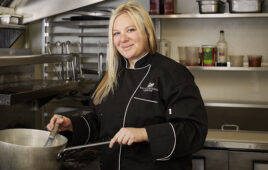For Nelson Millán, Executive Chef of San Antonio (Texas) Country Club, the best dishes and menus aren’t written on a whim. Instead, they’re a careful blend of creativity, study and hard work.
I was talking over the phone with a colleague a few days ago who moved to Hong Kong five years ago for an amazing career opportunity. We were catching up on life, family, business, and careers. We hadn’t talked since he left so it was refreshing to reconnect. I learned that he’s now back in USA in Idaho with yet another great career opportunity.
He started in Hong Kong as the Executive Chef of The American Club’s two facilities—one in the city and one in the country. He was quickly promoted to Director of Food and Beverage Operations. Now that he’s back in Idaho, he’s holding a similar position that “keeps him out of the kitchen,” as he says.
Part of our conversation was about composing menus. He mentioned how he is in need of a chef for the a la carte restaurants at this new club, but in the meantime, he needs to create menus because he is against the clock for their short summer season.
“When writing menus, you have to take advantage of the days that you are your most creative and write as many menus as you need because there will be days that you won’t be able to write even a good dish,” he said.
His comment resonated with me. I’m not the only one being challenged with menu writing on some days and it makes me wonder if there are more chefs who share this challenge with us.
In my previous blog, I wrote about the similarities between music composition and menu composition and about how both have to be harmonious to the ears and palate. If you further analogy, my hope is that every dish I write becomes a Top 10 Hit with my members here at San Antonio (Texas) Country Club.
As club chefs, one of the key challenges we face daily is to keep our menus varied, creative and refreshed. We cater to a captive audience as opposed to a restaurant, hotel or resort chef who caters to a transient clientele. Our members come to enjoy the a la carte restaurants, outlets and banquet events at least three or four times per week so a newly rolled out menu could quickly become old and tired in the matter of weeks or months. We see most of our same members at every social event, too, therefore we are often challenged to compose menus to entertain the crowds with something that has not been seen before (but, at the same time, isn’t too far out of the box).
How many ways can we prepare a chicken breast or carve a beef tenderloin? Where do we find the inspiration to compose great food that is new and different (but not too different) and have each dish connect with our members every time they eat with us? These questions have many answers, but here is what has worked for me throughout my career in clubs.
I still remember my early days when I couldn’t tell the difference between cilantro and parsley because they looked so much alike. It wasn’t until I got closer to these ingredients, to feel, touch, taste and smell them individually that I could register their particularity and uniqueness. From that point forward, I realized that I had a lifelong exercise in front of me. I must establish an intimate relationship with every individual food product to learn how it behaves in different scenarios, cooking processes and techniques. This helps me balance them on the plate when composing a dish. I have found this ingredient study to be the backbone of any dish or menu I create. I also read books, magazines, blogs and scroll through a fair share of social media pictures. And I make it a point to attend at least one or two culinary conferences a year, plus take a culinary trip to a foreign country. None of these things substitute the close relationship I must form with old and new ingredients. I have learned the proper way of processing them and the techniques that each requires. If you do the same, you will develop a laser-sharp ability to elevate details others might overlook. These details are what make Top 10 hits.
It would be nice to have a crystal ball that could tell us what our members menu preferences will be. But food preferences are as bountiful as ingredients. All we can do is educate ourselves and compose dishes and menus that reflect what we learn and discover. I’m sure we’ll still always have days when we can’t produce a hit dish, but as my friend suggested, take advantage of the days you can. And soon enough those dishes will all appear on your members Top 10 Hits list.




